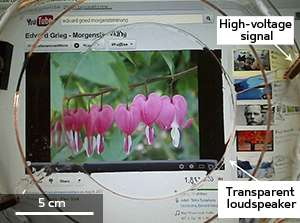Stretchable electronics: A gel that is clearly revolutionary

Researchers are determined to manufacture stretchable biomedical devices that interface directly with organs such as the skin, heart and brain. Electronic devices, however, are usually made from hard materials that are incompatible with soft tissue. Choon Chiang Foo from the A*STAR Institute of High Performance Computing, Singapore, and researchers at Harvard University, United States, are aiming to solve this dilemma with squishy, see-through gels that can act as integral components of stretchable devices thanks to an innovative ionic conduction mechanism.
Foo and co-workers made their discovery while investigating a promising 'artificial muscle' technology known as dielectric elastomers. These devices sandwich an insulating rubber polymer between two conductive electrodes, typically made from micro-cracked metals or carbon grease. Applying a voltage to the electrodes builds up pressure which causes the inner polymer to expand. Most electrode materials, however, begin to lose conductivity when subjected to high strains.
The researchers chose to replace the electrodes in dielectric elastomers with soft hydrogels. Hydrogels are transparent and biocompatible materials, typically used in contact lenses, which encapsulate salty ions and water inside a polymeric sheath. Replacing the electrodes requires overcoming two well-known limitations of ionic conductors: their slow speeds relative to electron conductors and a tendency to undergo destructive electrochemical reactions at high voltages.
The team's setup addresses these problems by placing a thin insulating rubber sheet between two hydrogel layers. Electric signals sent to the hydrogel through tiny electrodes leads to rapid buildup of oppositely charged ions on each side of the rubber sheet causing the sandwiched device to thin and expand over the entire area. Furthermore, the rubber layer has a remarkably low capacitance, which causes a large voltage drop across the rubber and shields the hydrogel from electrochemical reactions, even at kilovolt ranges.
To demonstrate the high-frequency operation of their stretchable ionic material, the researchers produced the world's first gel-based transparent loudspeaker (see image). This device, which could be placed over a smartphone or flat-screen television screen, resonated thousands of times per second over the entire audible range.
Foo, whose theoretical contributions proved critical to understanding the novel behavior of these stretchy gels, believes this work may lead to a fundamental shift in how engineers conceive electronic devices. "Because existing conductors struggle to meet the demands of stretchable applications, device designers may begin to ask if they can replace electronic conductors with ionic conductors," he explains.
"The device may lose some performance but may gain other attributes, such as stretchiness, transparency and biocompatibility."
More information: Keplinger, C., Sun, J.-Y., Foo, C. C., Rothemund, P., Whitesides, G. M. & Suo, Z. "Stretchable, transparent, ionic conductors." Science 341, 984–987 (2013). dx.doi.org/10.1126/science.1240228
Journal information: Science




















